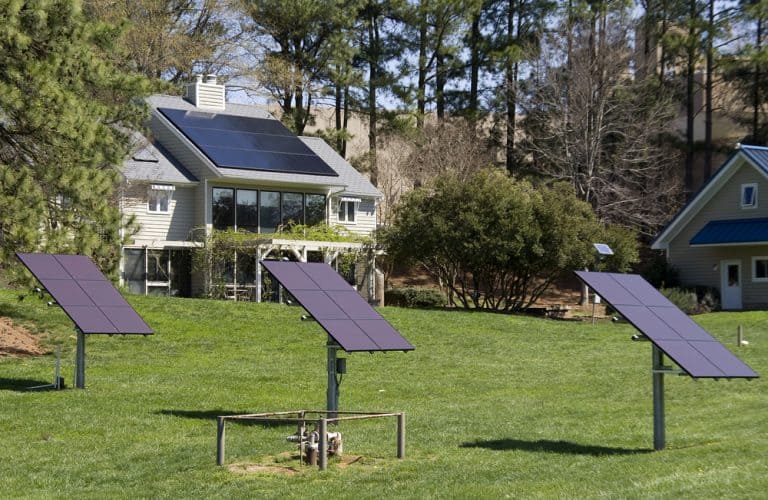Backyard Solar Panels: 5 FAQs

When acquiring residential solar, people often think of standard rooftop mounts. However, homeowners can also have solar panels installed in their backyards in the form of a ground mount.
If you are thinking about putting solar in your backyard, this is the post for you. Below are five backyard solar panel questions and their answers.
1. How are Backyard Solar Panels Different Than Rooftop?
Backyard solar panels are actually the same. The difference is extra labor, permitting, and the mounting system used. There are also different electrical code standards for installation, but as a consumer, you don’t need to worry about these.
Often there is more labor required when a backyard system is installed. This is because the solar panels need to be secured to the ground instead of a roof. The solar panels also aren’t as close to the home which, requires more wiring.
Permitting regulations for solar panels installed in a backyard is also different. These regulations, however, are dependent on the location of the home.
Lastly, there are different mounting methods used. Typically backyard solar is either a ground mount or a pole mount.
Ground mounts have several metal poles secured in the ground. A racking system is secured to the poles, which hold the entire solar array above the ground. A pole mount, which is less frequently used in the installation, uses one large pole to hold a solar array in the air.
2. When are Backyard Solar Panels a Better Option?
If your home is a good fit for solar, it will be more economical to install solar on your roof. However, there are instances when individuals prefer backyard installations.
Although solar panels have a sleek design, some don’t think they look good on the roof. Aesthetics, far more frequently than installing the system for efficiency, is a reason why people choose to put solar panels in their backyard.
Another reason why solar may be a better fit for your backyard is if your home isn’t a good fit for solar. If a roof doesn’t have enough unshaded space, it may not be the best place for solar.
This may also be the case if your roof doesn’t have enough pitch facing the right direction. Solar panels work best when they face south, but east and west facing solar panels are still effective.
3. What are the Requirements for Backyard Panels?
When solar panels aren’t installed on the roof they have different requirements. What is required depends on where the home is located. One of the main reasons why installing solar panels in the backyard is difficult is space.
Putting solar panels on the roof utilizes unused space. However, when solar panels are installed in the yard, it takes up space that may have otherwise been used.
Go Solar Group’s Axitec 315-watt solar panels need 17.875 square feet per solar panel. The smallest backyard installation completed with these is six solar panels. This means that at the least, a backyard array would need 107.25 square feet.
This, however, isn’t including setback regulations. A Setback is a required distance between a solar array and the property line. These distances are different for each jurisdiction.
At Go Solar Group, we have seen setbacks for backyard solar installations as small as 5 feet or as large as 20 feet. This, however, is not a minimum or maximum; it just gives an idea of what to expect.
4. How Much do Backyard Solar Panels Save?
One of the reasons why solar is such an attractive option right now is the money people save when they get it. Backyard installations don’t have the same return on investment as rooftop solar. However, they do still save money.
The reason this installation type doesn’t have as quick or consistent of an ROI is that it takes more materials and time to build. On top of this, the permits can cost more. If, however, your home is better suited for a backyard installation, the return is still worth it.
5. How Many Solar Panels Needed to Power a House?
How many solar panels are needed to power a home is a bit of a loaded question. The first thing needed to calculate this is the home’s electric usage over the past year. Month-to-month electric usage over the course of a year gives an accurate picture of the energy needs of the home.
After usage has been collected the next step is to determine which solar panels are being used. The solar panel size and type makes a big difference in how many are needed.



Send a Message
Oops! We could not locate your form.